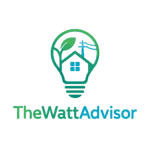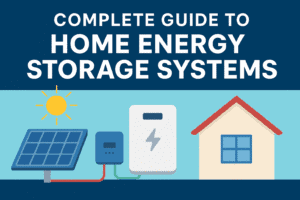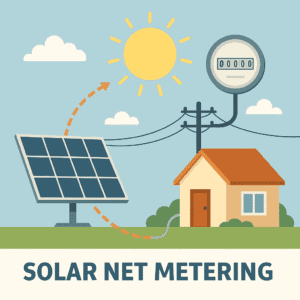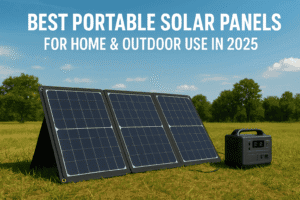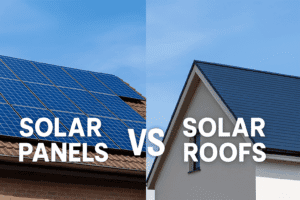Complete Guide to Solar Inverters for Homes (2025 Edition)
Why Solar Inverters Are Essential for Every Solar Home
If you’ve been exploring home solar energy solutions, you’ve probably come across the term solar inverter more than once. Solar panels get the spotlight, but solar inverters are the real brains behind any solar setup. They convert the direct current (DC) generated by your panels into alternating current (AC) that powers your lights, appliances, and even EV chargers.
In this complete guide, we’ll walk you through everything you need to know about solar inverters for homes, what they do, the different types available, how to choose the right one, installation tips, maintenance, and more.
Whether you’re installing your first solar energy system or upgrading your existing one, understanding how solar inverters work is crucial for maximizing efficiency, performance, and savings.
Table of Contents
- What is a Solar Inverter?
- How Do Solar Inverters for Homes Work?
- Types of Solar Inverters
- String Inverters
- Microinverters
- Power Optimizers
- Hybrid Inverters
- Key Features to Look for in Home Solar Inverters
- Choosing the Right Inverter Based on Your Needs
- Cost of Solar Inverters for Homes in 2025
- Installation Considerations
- Solar Inverter Maintenance Tips
- Common Problems and How to Fix Them
- Solar Inverter Brands to Trust in 2025
- Solar Inverters and Battery Storage Systems
- Do You Need a Solar Inverter with Net Metering?
- Off-Grid vs Grid-Tied Inverter Systems
- Smart Solar Inverters: Are They Worth It?
- Solar Inverter Warranties & Lifespan
- DIY vs Professional Installation
- The Role of Solar Inverters in Energy Efficiency
- Final Thoughts
- FAQs About Solar Inverters for Homes
1. What is a Solar Inverter?
A solar inverter is a device that converts the DC electricity produced by your home’s solar panels into AC electricity, which is used by all the appliances and systems in your house. Without it, your solar panels are practically useless unless you’re storing power directly in a battery.
Why You Need One:
- AC electricity is what your home runs on
- Enables net metering
- Helps monitor solar system performance
- Ensures compatibility with battery systems

2. How Do Solar Inverters for Homes Work?
Here’s the basic process:
- Solar panels absorb sunlight and produce DC power.
- That DC electricity flows into the solar inverter.
- The inverter transforms the DC into usable AC.
- AC electricity flows through your home’s circuit.
- Excess power can be stored in batteries or fed back to the grid.
Some advanced solar inverters for homes also come with built-in performance monitoring, allowing you to track solar energy generation and usage in real-time.
3. Types of Solar Inverters
Let’s break down the main types of solar inverters for homes:
🔌 String Inverters
- Most common type
- One inverter handles an entire string of solar panels
- Cost-effective but limited performance in partial shading
🧠 Microinverters
- Installed on each individual solar panel
- Excellent for roofs with shading issues or multiple angles
- More expensive but offer higher efficiency
⚡ Power Optimizers
- Work with string inverters to optimize individual panel output
- A balance between cost and performance
🔋 Hybrid Inverters
- Support both solar and battery storage
- Ideal for future-proofing your energy system
🔗 Related Post: Solar Battery Storage: Is It Worth It in 2025?
4. Key Features to Look for in Home Solar Inverters
When buying solar inverters for homes, consider the following features:
- ✅ Inverter Efficiency Rating (higher is better)
- ✅ Grid compatibility (net metering support)
- ✅ Battery readiness
- ✅ Smart monitoring app or portal
- ✅ Safety certifications (UL, IEC, etc.)
- ✅ Warranty (10+ years preferred)
5. Choosing the Right Inverter Based on Your Needs
| Criteria | Recommended Inverter Type |
|---|---|
| Budget-conscious | String Inverter |
| Partial roof shading | Microinverter or Optimizer |
| Planning battery backup | Hybrid Inverter |
| Need panel-level monitoring | Microinverter |
| Complex roof layout | Microinverter |
🔗 Helpful Resource: How Smart Thermostats Save You Money
6. Cost of Solar Inverters for Homes in 2025
| Type | Price Range (USD) |
|---|---|
| String | $700–$2,000 |
| Microinverter | $100–$250 per panel |
| Hybrid | $2,000–$4,000 |
| Power Optimizers | $50–$100 per panel |
Prices vary based on system size, brand, features, and whether battery integration is included.
7. Installation Considerations
Always hire a certified solar installer unless you’re fully trained and licensed. Key steps include:
- Correct sizing of the inverter
- Mounting near electrical panel or battery bank
- Ensuring compatibility with your solar array
- Permits and local utility requirements
8. Solar Inverter Maintenance Tips
- Check your monitoring app regularly
- Clean inverter vents to prevent overheating
- Listen for strange sounds or error codes
- Schedule annual inspections
Most inverters last 10–15 years with proper care.
9. Common Problems and How to Fix Them
| Problem | Likely Cause | Fix |
|---|---|---|
| Low power output | Dirty panels or shade | Clean panels or optimize layout |
| Error codes | Grid voltage issues | Contact utility/installer |
| Inverter not turning on | Fuse or wiring problem | Check connections |
| Overheating | Poor ventilation | Improve airflow |
10. Solar Inverter Brands to Trust in 2025
- Enphase Energy – Top microinverters
- SolarEdge – Leading optimizer-based inverters
- SMA Solar – Reliable string inverters
- Fronius – Highly efficient hybrid inverters
- Growatt – Budget-friendly hybrid options
11. Solar Inverters and Battery Storage Systems
If you’re planning to add battery storage (like Tesla Powerwall or Enphase IQ Battery), your solar inverter must be compatible. Many solar inverters for homes now come with battery ports and management software.
🔗 Related Post: Solar Battery Storage: Is It Worth It in 2025?
12. Do You Need a Solar Inverter with Net Metering?
Yes! Net metering requires converting your solar energy into grid-compatible AC, and that’s only possible with a solar inverter. Some advanced inverters allow you to control how much energy is sent back to the grid.
13. Off-Grid vs Grid-Tied Inverter Systems
| Feature | Grid-Tied Inverter | Off-Grid Inverter |
|---|---|---|
| Requires battery | No | Yes |
| Can export to grid | Yes | No |
| Needs grid to operate | Yes | No |
| Backup power | Only with battery | Yes |
Choose based on your location, utility policies, and energy independence goals.
14. Smart Solar Inverters: Are They Worth It?
Smart solar inverters for homes come with built-in monitoring systems, alerts, optimization tools, and sometimes even remote diagnostics. They’re a must-have if you want to:
- Track energy production
- Detect faults quickly
- Adjust for seasonal performance

15. Solar Inverter Warranties & Lifespan
- Average lifespan: 10–15 years
- Warranty period: 10 years standard, extendable to 20 years
- Check what’s covered: parts, labor, service calls
16. DIY vs Professional Installation
DIY inverter installation is not recommended unless you are licensed and experienced. Mistakes can cause system failures, code violations, or void warranties. Always go with a certified installer.
17. The Role of Solar Inverters in Energy Efficiency
A high-efficiency solar inverter for homes ensures that the maximum power from your panels is used or stored. Without a good inverter, even high-end solar panels may underperform. Think of it as the power conductor of your home.
🔗 Also read: Top 10 Energy-Saving Tips for Winter
18. Final Thoughts
Solar inverters for homes are essential, and their role in maximizing solar efficiency cannot be overstated. Choosing the right inverter ensures that your solar investment performs well year-round. From string inverters to hybrid models ready for battery backup, the right technology can enhance comfort, reduce bills, and promote sustainability.
Ready to dive deeper into DIY upgrades and solar strategies?
👉 Explore our Ultimate Guide to Home Energy Efficiency
👉 Or learn how to perform your own Home Energy Audit Checklist (Free PDF)
19. FAQs About Solar Inverters for Homes
This post was on Solar Inverters for Homes.
